HOME | ABOUT US | MEDIA KIT | CONTACT US | INQUIRE
HOME | ABOUT US | MEDIA KIT | CONTACT US | INQUIRE
By providing exceptional health care, the 2022 Top Doctors produce outcomes that strengthen entire communities.
The Omnipotence Paradox holds that there can be no winner when the fabled irresistible force meets the unmovable object.
But that’s not always the case, now, is it?
Just look at health care. Going on three years ago, a fairly irresistible force was unleashed on the world in the form of a virus with pandemic reach. Here in the Kansas City region, it met its match: A medical community that continues to stand fast today.
You see these immovable figures in the faces of Ingram’s 2022 Top Doctors—15 physicians from a broad range of medical disciplines that include cardiology, pulmonology, plastic surgery, emergency medicine and more.
COVID-19 changed the way many in health care practiced the healing arts. For some, it was a wholesale revision of work routines, and people deferred preventive care and shunned medical facilities during the peak of the pandemic concern. For some others, the impact was minimal—the emergency room or, in many cases, the operating room filled with patients whose needs were both unanticipated and urgent.
It’s interesting how these physicians, exemplars of competence and compassion that their peers say they’d be looking for to treat themselves or a member of their family, now view what they do from a new perspective. They have a renewed appreciation for what it means to be alive, what it means to be healthy to enjoy life, and what their work does to help others fully embrace life’s promise and potential.
For more than 25 years, Ingram’s has sounded out the leading health-care providers in this region to help determine who among their ranks delivers the highest levels of care. This year’s honorees again stand tall with that distinction. And what they bring to this region is not limited to patient care alone: By providing for their patients, they help make the Kansas City region a leading light in health care, drawing talented workers to the Heart of America and elevating an entire community in the process.
Please join us in congratulating them and thanking them for all they do.
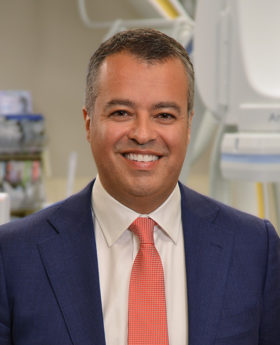 Luis Couchonnal
Luis Couchonnal
Healient Physician Group/St. Joseph Medical Center
His father was a physician. His paternal grandfather was a physician. His maternal grandfather? Yep, a physician. So the first steps on his path to cardiology might not have been pre-ordained, but there’s no denying the influences that steered young Luis Couchonnal through Rockhurst High School, Notre Dame, and back home to the University of Kansas School of Medicine. Couchonnal is with Healient Physician group, which specializes in cardiology cases, but he’s in a niche within that niche as a cardiac electrophysiologist. “Patients usually see a regular cardiologist or interventional cardiologist before they see me,” he says. “I tell them, ‘you’ve seen the plumber; I’m the electrician of the group, working with pacemakers, defibrillators, atrial fibrillation ablations and ITC ablations,” he says. His father’s work as a specialist in infectious diseases was a distinctly different discipline, but the lasting influence came from accompanying him on his rounds and watching the way he took care of patients and interacted with them. Couchonnal was determined from an early age to merge his interest in science with a goal of helping other people. Cardiology filled that urge, he says, because it “involved a lot of science and tech.” The deal was sealed during his training at Emory University in Atlanta, where he witnessed the power of cardiology to elevate a patient’s quality of life. “The thing I think is unique about my practice, this is a bit of smaller practice group, so we can offer more personalized care,” he says. “It’s important that when patients need to be seen, that they are seen quickly, that means the same day or within 24 hours. That should be something all health-care systems should strive for. We’re really focused on taking care of the patients when they need you, not to wait three months. Taking care of them earlier on in their illness, so they don’t get worse and then have to be admitted to the emergency room and have a longer recovery period.” Couchonnal needs not look far to find validation for his choice of cardiology. One recent case he recalls involved a patient whose heart issues had rendered him unable to do simple daily activities. “We found an abnormal heart rhythm and we were able to cure it,” he says. “Within a few weeks, he was feeling better, exercising, and off the medicines he had been on. His heart function went from 20 percent to normalizing, up to 60 percent.” The patient wrote a letter thanking him for the successful treatment and describing the change in his quality of life. “Those kinds of cases,” Couchonnal says, “make you feel good about yourself, motivate you to become a better physician to offer those outcomes to everyone. I don’t look at what I do as a job; I look at it as a passion. I don’t feel like I go to work—I feel like I get to help people every day.”
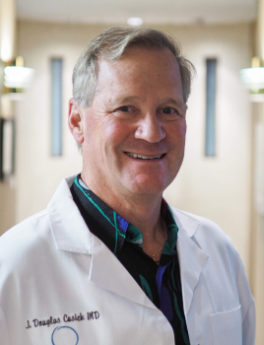 Doug Cusick
Doug Cusick
Cusick Plastic Surgery/AdventHealth
One can make a nice living as a physician—but not without first paying some serious dues. Consider the case of Doug Cusick, a plastic and reconstructive surgeon in Leawood. More than 35 years since medical school at Oral Roberts University, he’s still helping people regain their health and self-esteem. And not just in this region, but around the world through an exhaustive and extensive series of overseas mission work. Retirement? “I haven’t thought about it,” he says. “There are two reasons for that: One, I didn’t finish my education until I was 34. I went to my 15-year reunion from Shawnee Mission South, and some were already millionaires and one was on his third wife, and here I am, still in residency.” The second reason, unsurprisingly, is that he finds his work “tremendously rewarding.” His interest in surgery began when he was just a kid, he says, “and continues to this day. It’s something that’s so satisfying, I don’t hardly see it as work. It’s nice to have patients that are so happy, so thankful, giving you hugs.” After an undergraduate path through Washington University in St. Louis, then KU, for a business degree, he settled on medicine. But before heading to Tulsa for his M.D., he spent a year in Scotland, and came back with two life-changing influences: One was Barb, his wife of 39 years; the other was a burning passion for mission work overseas. “I went to ORU for medical school because they send you on missions, and my real goal all my life has been medical missions.” To date, he’s been on 54, counting this month’s trip to Peru. In roughly two dozen countries, he’s brought a sense of normalcy to the lives of children too poor to afford surgery for maladies like lip and cleft palates or facial and head cancers, or people who needed noses or ears rebuilt after infection or injury—almost anything, he says, that “brings back self-worth and self-esteem.” As passions go, his work isn’t far removed from his hobby; Cusick rebuilds antique musical instruments in his spare time. Some of those are two centuries old and entail delicate reconstruction of valves and pneumatics. “Plastic surgery is just like working on instruments,” he says. “Fixing tendons, nerves, working under the microscope. It’s just exactly like restoring those instruments, and it’s one reason I got into the field.” Cusick sees patients at multiple hospitals in the area and serves as a clinical instructor for KU’s school of medicine. His own practice hasn’t been as disrupted as other niches during the pandemic, but the experience of the past 2½ years has given him a new appreciation for what he does. “I’ve come to realize how vulnerable we are as people,” he says. “There’s also a specific population who are vulnerable, and we need to protect them. Our responsibility as a community and in medicine is to protect people from all disease, not just COVID.”
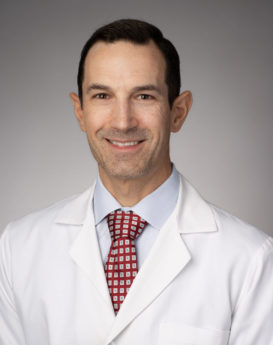 Jason Eppler
Jason Eppler
Research Medical Center/HCA Midwest Health
Jason Eppler was not yet 10 years old when his father—then in his 30s—suffered a heart attack and underwent bypass surgery. That experience made one lasting impression. Another came from observing the physicians who treated his dad and the quality of care and compassion they brought to the task in the decades that followed. “He did very well, is still alive and doing well today, and that’s a testament to having excellent physicians and surgeons,” Eppler says. That, and an inspirational pediatrician who mentored him in middle and high school, helped seal the deal on a career in medicine for Eppler. A microbiology and biochemistry major in college, Eppler pondered a Plan B in an engineering discipline, but health care won out. At first, pediatrics seemed like a natural path, but “I realized I enjoyed seeing all ages of people, specifically doing procedures,” he says. Part of that appeal of ER, he says, is that “it’s never the same two days in a row. The other benefit comes along is the patient variety, getting to see patients of all ages. In ER, you’re kind of an investigator, where the presentation is not always the same every time. So you put on that investigator hat, and you look to connect dots. I love that ability with the team to impact patients in their moment of greatest need, that golden hour when people are critically ill or injured, and you have to act fast. It puts all your skills to the test, all at once.” It’s a different type of health-care delivery, because by its nature it precludes long-term relationships with patients. “There’s just a bit of a brief reward with the gratification because you don’t have that continuity of care,” Eppler says. “Sometimes, I do get patients who are able to come back and provide some follow-up, but those are few and far between. It’s something I did miss from a family medicine standpoint, but at the same time, it makes you hone your skills when you only have a few minutes to break the ice and establish a relationship with a patient and have them instill their trust in you.” In ER, he says, some cases stay in your mind more than others, “and some you try to repress.” But a powerful validation of his ER work came not long ago when a car-accident victim was rushed in, and paramedics suggested that he might have had a stroke. “Because they made that astute call, we mobilized our stroke and trauma teams, everyone was ready,” Eppler says. “The next day, I was amazed to see him sitting up in bed, moving everything, talking appropriately. He was discharged three days later with no deficits whatsoever. That was impactful because it was a tremendous demonstration of the power of additive resources coming together and working seamlessly. It validated why I enjoy working in a busy trauma unit at Research, because we have the ability to make a big impact on people’s lives.”
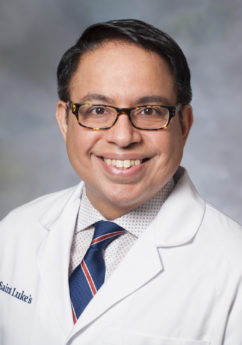 Gurpreet Gandhoke
Gurpreet Gandhoke
Saint Luke’s Hospital/Saint Luke’s Health System
It’s a request that would be tough for anyone to ignore: On her deathbed, Gurpreet Gandhoke’s grandmother left him with a final regret—she wouldn’t live long enough to see a stethoscope around his neck. “I was very close to her,” he remembers, “and I said, ‘This is it: This is what I will do with my life.’” From his roots in India, he made his way through medical school focused, on becoming a neurosurgeon, and charted his final stages of training through residency, including a stop in the U.S. It would be a brief one because he had a job guaranteed to him in India. “A mentor told me that before I start earning money, I should go to the U.S. for a month, then come back.” In the States, though, Gandhoke started working on the math. India had a population-to-neurosurgeon ratio of roughly 1 million to one. In the U.S., it was closer to 65,000 to one. That calculation, and the factor we think of as the Kansas City Hook, grabbed him after he finished his neurosurgery training in Pittsburgh. Instead of a year or two stateside, he said he and his family had reached a conclusion: It would be better to raise their daughter here. He had seen San Francisco, Phoenix, and Chicago, among others, but Kansas City seemed to be a big city without the problems of most big cities. He’s a neurosurgeon, he says, because “you can make a significant impact in people’s lives. I’ve dealt with a lot of trauma and injury, especially spinal trauma. If you do it at the correct time, it can even save a young life. I can now claim to have saved 50 to 100 young lives who, if we had not intervened, would have died. They can grow up, go to work and feed their families for a lifetime. That is unsurpassable: I can’t think of another specialty that has the satisfaction of making such a huge impact on someone’s life so quickly.” He came here 4½ years ago, and half that time has been spent in a pandemic emergency that has changed health-care delivery around him. One change of many, he said, is telemedicine, which “gives you a new perspective on the delivery of care. There are many things we can accomplish with it.” Health systems have also learned the importance of triage, with a better understanding of “who do we need to get to first to treat. We became very good at that, helping patients in time before things led to adverse outcomes.” On a personal level, Gandhoke says, “I learned that no matter how well-educated, well-trained you are, nature has its way of reminding you that in the grand scheme of things, we are all just specks of sand.” If he could do one thing to promote change within health care, it would be to eliminate the fear among physicians that leads to the practice of defensive medicine. The entire system, Gandhoke says, suffers because “unnecessary tests are ordered, time is wasted, and it’s a burden on the economy and the nation.”
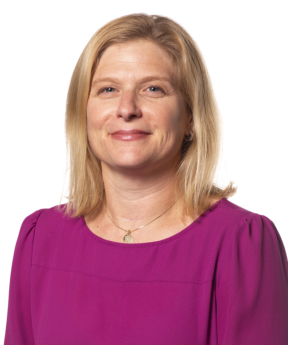 Jennifer Goldman
Jennifer Goldman
Children’s Mercy Kansas City
Jennifer Goldman’s grandfather was a radiologist, but she never got to meet him—he died before she was born. His influence touched her nevertheless; she says: “I grew up hearing wonderful stories about his life as a physician.” Those stories would form a backdrop years later after she finished college and was still unsure about a career path. Two years in the Peace Corps, reinforcing her love for learning about different cultures, exposed her to health-care instruction in Cameroon, helping villagers learn about vaccinations and the need for clean water. Back in the states, she worked with the Arthritis Foundation in New York, developing community-based exercise programs. “My favorite part of that job was listening to a doctor who volunteered once a week,” Goldman says, and as that rheumatologist dealt with questions from patients, she found herself hooked. “That is when I decided to apply to medical school,” she says. “I thought initially I would become a rheumatologist, but all the interesting infections I saw during the Peace Corps led me to infectious diseases!” Having seen a different side of the world, she returned to her hometown with an appreciation for the city and its people and for the opportunities to assist the youngest patients in the region. “When you treat a child who is very ill in the hospital—sometimes you are unsure if they will recover and if they do, to what extent?” Goldman says. “One of the best moments that can happen is when you are walking down a hospital hallway and look up to see your patient who was so ill at one point now walking down the hall, maybe returning for a follow-up appointment at the hospital. They are in street clothes and well-appearing, and their parents stop to talk and provide you an update of how well their child is doing. That feeling never gets old.” Given her specialty, she had an informed view of the potential threat during the COVID-19 outbreak. “The pandemic was hard for all of us in medicine,” Goldman says. “As a pediatric infectious diseases doctor, I was expected to be up-to-date on ever-changing data at all times. Many of the treatments used in adults had little to no data available in children; however, we still needed to care for sick children who had COVID.” She says she was forced to become more comfortable with uncertainty and to become more flexible. “One of the best things to come from COVID has been meeting and working with so many people that educate and care for children in schools who are working so hard to keep everyone safe.” She would love to see all children have their basic health-care needs addressed, and is inspired by the words of former Surgeon General Jocelyn Elders: “You can’t educate a child who isn’t healthy, and you can’t keep a child healthy who isn’t educated.”
Emily Hillman
University Health
The career of an emergency-room physician involves the practice of a different kind of medicine, with a different kind of doctor-patient relationship says Emily Hillman, who calls it “live in a fishbowl.” For one thing, she says, “you don’t always have patient follow-up. I know this may sound strange, but I’ve learned the most from patients that I could not save. My job is to save people on the brink of death, but I can’t always do it, and that part is very hard. So I’ve learned to take what I can from the sickest of the sick and share that with my team.” Hillman didn’t come to ER work completely unaware: Her mother also worked in emergency rooms as a nurse. Her father would let her tag along, delivering mom’s lunch or dinner during a 12-hour shift, sometimes not having seen her mom for a day or two. Those trips, she said, “made it seem like a normal place.” As she grew, her mother nudged her toward medical school, instilling confidence in her by telling her, “we need doctors like you in this world.” The six-year program at UMKC was her ticket to that world, and when residency options came up, “I felt at home with ER, and lucky to be affiliated with University Health, because it has one of the oldest residency programs in the country for that.” She’s often asked why, since she’s such a good communicator, she chose not to go into primary care. “I tell them, ‘If everybody who’s good doesn’t go into emergency medicine, what kind of world would it be?” Hillman says. “I’ve never felt inconvenienced with patient care here; it was always expected that I would be busy. When I rotated to other departments, it felt different. I like emergency work—it’s always there, 24/7, and that sets well with my values.” For ER workers, COVID-19 was a bizarre experience, she says—scary at first because of the lack of information and data about what they were dealing with, then strangely beneficial. “In hindsight, the biggest thing I learned through that was the importance of leaning on your community, and those relationships are paramount. Our group of nurses and doctors really came together to support patients and each other, and we came out stronger in the end. At the end of the day, work is work, but the emphasis on people is what’s important.” Another thing she discerned from her pandemic experience is the increasingly important role of mental health services during a time of unprecedented stress across society. “I’d like to see more support and funding for mental health, support for drug and alcohol addiction,” Hillman says. “Especially in the urban core. I think that’s huge. That, and focusing on systematically breaking down structural inequities and racism that affect patient outcomes.”
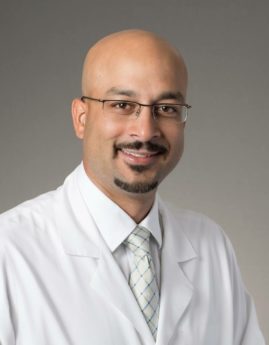 Corey Iqbal
Corey Iqbal
Overland Park Regional Medical Center/HCA Midwest Health
Corey Iqbal hit a health-care influence two-fer while growing up in St . Louis: His father was an anesthesiologist; his mother was a nurse. Perhaps what sealed the deal on his future came in the form of a severe cut he suffered on his hand, requiring a trip to the emergency room. “One of my earliest childhood memories was sustaining a bad laceration to my right ring finger,” Iqbal recalls. “I remember how caring the doctors and nurses were in the emergency room. They had such a calming effect on me as a frightened child.” The calming influence of the doctor who stitched him up, combined with his parents’ influence, Iqbal says, charted his own path to surgery. His mother, in fact, had surmised as much watching him tinkering with Legos as a child, and she “always told me I would make a great surgeon someday. She encouraged me to be creative, step out of my comfort zone, and blaze my own trail.“ That he did, following the six-year medical program at UMKC and 10 years of exhaustive training to become a pediatric surgeon. He wouldn’t have cleared any of those hurdles, he says, without the support of his wife, Amber, and now they have three children “who take an active interest in Daddy’s work—making rounds and decorating my office,” he says. “When Daddy misses a baseball game or gymnastics, they know he is helping a sick child. I am lucky to be loved and supported by such great people and want to thank them all.” Iqbal’s life could have turned out very differently had he followed up on a congressional nomination to the U.S. Naval Academy. A family friend who was a Navy officer synthesized Iqbal’s choice with med school or the academy. “You either want to take lives or save lives,” Iqbal remembers him saying, and “it was very clear to me at that point. I abandoned my pursuit of the military academies, and in 1997 I moved to Kansas City confident in my decision to become a doctor.” He gravitated to pediatrics in part because of volunteer service as a teen, serving youth-oriented causes. “In pediatric surgery, we refer to it as saving lifetimes,” Iqbal says. “However, it is hard to limit one’s passion for helping children to a single aspect. I think pediatrics attracts people for a number of reasons. I find working with children to be very humbling. Children do not care about titles, certifications, or publications; they just want to feel better so they can go back to being a kid—which is a persistent reminder of why I went into medicine in the first place, to help people.” Helping parents work through the emotional toll of a child on an operating room gurney, and having lived the same experience with his own kids, he says, has shaped his empathy as a provider.
 John Ireland
John Ireland
Saint Luke’s Pulmonary Specialists/Saint Luke’s Health System
Do you remember house calls? John Ireland does because his father—a small-town general practitioner in Richmond, Mo.—used to make those visits, and his son would occasionally tag along. “I remember going into people’s homes, seeing how he interacted with patients in that kind of setting, and I thought it was really neat that he went in and went over their medication list, examined them, talked to them—and when he was done, he talked with them a little longer. It was almost like they were a part of the family in that setting. … I think I just wanted to do what he did ever since I can remember.” And that he’s done, following his D.O. degree from what is now Kansas City University. Rather than general practice, though, young Ireland gravitated to pulmonology and critical-care medicine. “What really attracted me to it was the challenge of it, taking care of the sickest people, the physiology of that. I’m still kind of fascinated with it today.” Kansas City turned out to be, in some ways, a scaled version of Richmond, making it the right fit for his practice. “I talk the language here, talk to people who come in from smaller towns and even go to smaller towns in outreach clinics, where I can sit and talk to my kind of people,” Ireland says. “If you put me in a New York or Los Angeles, I’d be a fish out of water.” As a specialty, critical care gave Ireland a front-row seat in the waves of hospitalizations throughout the pandemic. “It was just exhausting at times, taking care of really sick people, seeing the amount of death that I saw over the past couple of years,” he says. “More than anything, what that experience did for me was give me a greater appreciation of the time that I spend with my family and loved ones. It probably made me more empathetic too, and that carried over to being a better physician, from that standpoint.” The nation’s health-care system, in some ways, is like a sick patient, and Ireland has a couple of prescriptions he’d like to write for it. “We want to deliver the best quality health care to patients, so if it came down to one thing—I can think of a couple of things—but lowering the cost of health care across the board,” he says. “That would allow us to deliver care to more people with better outcomes. Waving a wand and lowering costs would probably be the biggest benefit to all.” He’d also press to lower the debt burden on physicians from training. “I came out with a lot of debt, but now there are people $300,000 or $400,000 in debt, and I don’t know how sustainable that is,” he says. “You want your brightest people to go into health care and become physicians, but taking a decade of your life in training, medical school, and post-graduate to come out that much in debt is not very appealing.”
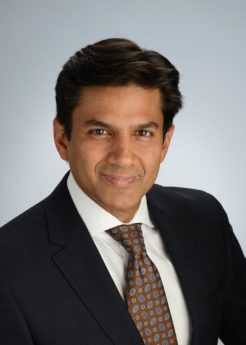 Talal Khan
Talal Khan
The University of Kansas Hospital
It should come as no surprise that the path to medical school is much easier to navigate than the path to space. For Talal Khan, the commitment to a medical career took root early—”maybe late elementary to early middle school; I never really considered viable alternatives,” he says. “I did at one point want to be an astronaut and maybe combine my interest in medicine and being an astronaut; however, at the time I did not see a clear path to that.” Thus did this native of Pakistan begin a journey that would bring him to anesthesia as a specialty and to Kansas City as a practitioner. He goes well beyond those duties as department chair for anesthesiology at KU’s School of Medicine, sits on the board of directors for the hospital’s health system, and is president of The University of Kansas Physicians group. The early appeal of health care formed while watching the care his father received for a chronic illness. “That first-hand witness to medical expertise and empathy helped form my early goals to a career focused on service and utilizing the latest advances to improve lives,” Khan says. Anesthesiology, perioperative and pain-management medicine presented exciting and dynamic possibilities. “Anesthesiologists manage myriad considerations to optimize the patient from the medical standpoints to help achieve excellent outcomes,” Khan says. “We use the latest technological advances in monitoring and intraoperative imaging with ultrasound or echocardiography to make second-to-second decisions to positively impact the surgical outcome.” He’s particularly excited about pain medicine, a field that has seen huge advances over the past 20 years. “Pain is one of the most common symptoms that drive a patient to seek medical care,” he says. “Chronic pain is a huge public-health concern resulting in significant disruption to quality of life and ability to function.” Throughout his career, the learning has never stopped—especially in the pandemic era. “This particular crisis of a lifetime provided many learning opportunities,” he says. “I have learned to approach life and nature with an even greater degree of humility, recognize the humanity in others, think about investing more time and effort in thinking about and preparing for the next health-care crisis, support our teams in medicine that have been on the forefront of this relentless adversary, and try to harness everyone’s creative ideas to provide outstanding care in the face of great challenges.” Khan thinks deeply about the myriad challenges to better population health, and says that one way to elevate care broadly would be with “more focus on preventive care, public health, and education,” he says.
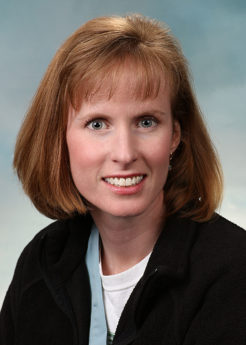 Elizabeth Long
Elizabeth Long
Olathe Health
Sibling rivalries date back to Cain and Abel, so it was perfectly natural for Elizabeth Long to engage in a bit of competition with her twin brother growing up in Prairie Village. But extending that into medical school? Not many doctors have lived that. “Both of us, at the age of 17, decided independently to go to med school,” Long recalls. “We ended up going together at KU, and it was really good. We had a healthy competition, and we helped each other, but each of us wanted to be better than the other.” The family component, then, has always been a part of her career track—especially with a great grandfather who was a small-town doctor, a cousin who’s a physician, and several dentists. During medical school, she pondered emergency medicine, but after experiencing it on her rotations, “let’s just say I didn’t care for it,” Long says. “I was immediately thinking about all these loans I’d taken out for school, oh my goodness, but the next rotation was surgery, and I just knew I was home.” She recalls an early observation of an operation and thinking, “I want to be that person, doing all that. I pretty much never looked back at all. It just clicked in my head and heart, fit my personality. I like to “greet, treat and street” them, identify the problem, solve and move on.” What she learned through her medical career is that no two specialties are exactly alike. “There’s a branch of medicine that fits every personality,” she says. “It wouldn’t excite me to treat diabetics throughout their lives, for example.” Surgery then was a big-time save. “There was no backup plan. I really had no other career path,” Long says. “I would have been in big trouble if things didn’t work out!” She does double duty as chief medical officer for Olathe Health, a role that has given her additional insights into the impact of COVID-19 on the profession. “The biggest impact was the significant migration away from health care, their careers, for the staff,” she says. That has meant a lot of short-term use of traveling nurses and other staff, which fills a need but presents other issues. “A lot of new and traveler positions don’t really know our system as a provider, so we really had to up our game to ensure that the T’s are getting crossed, and I’s dotted,” Long says. She’s also concerned that treatments delayed by patients, especially during the first pandemic year, are now presenting as much more advanced and aggressive illnesses. “The complexity level is so much higher because they did wait,” she says. But all of it, from staffing shortages to supply-chain issues, has created an urgency and a new emphasis on problem-solving. “We have definitely learned,” Long says, “to be more flexible and more creative.”
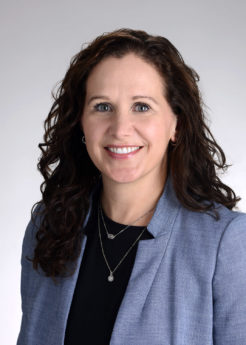 Becky Lowry
Becky Lowry
The University of Kansas Hospital
A college degree, a medical degree, years of hospital rotations, fellowships, and residencies. After all that, it’s not in one’s nature to answer a question with “I don’t know.” The ability to admit that—and then to pivot into a solutions mode—just might be health care’s silver lining from the pandemic that has ravaged the world for 2½ years, says Becky Lowry. An internal medicine specialist for The University of Kansas Hospital, Lowry looks back on her organization’s experience and proudly declares that a number of lessons have been learned. “We have learned we can do things that we didn’t think possible,” she says. “We have learned better how to say ‘I don’t know,’ which can be hard but is important to acknowledge. We have learned how to adapt more quickly to rapidly changing information than we thought possible. We also, I genuinely believe, have learned how important it is to take care of ourselves and our medical community.” Lowry is a native of southwest Kansas, the daughter of a farmer and a registered nurse. “My parents and grandparents modeled for my sister and me compassion, hard work, and dedication and really encouraged finding meaningful careers that provided a service to others,” she says. “They were deeply committed to caring for others in their lives.” She carried that forward first as a physical therapy and medical assistant in high school and college and planned a PT track. Then she discovered the challenge and complexity of medical decision-making and developing care plans. That took her to KU’s school of medicine and then internal medicine after a brief consideration of pediatrics. “While I loved both, I found that in IM, I could have the privilege of walking through health journeys with patients and families for decades and through that time could work through many complex clinical situations,” Lowry says. She leveraged a background in both fields to become medical director for the Survivorship Transition Clinic with the hospital’s cancer center. Her leadership role has also heightened her awareness of how care isn’t just a consideration for patients. “In medicine, we have to care for our health-care workers,” she says. “We must create professional workflows and structures that support the well-being of the health care team members. Physicians and health-care workers are humans. We are strong. We are resilient. We are dedicated to the calling of serving our patients. We know from data and experience that we do this best when we are healthy and well ourselves.” The pandemic, she says, “demonstrated the incredible strength of physicians and health-care workers and also forced us to acknowledge we have limitations and our systems have opportunities.”
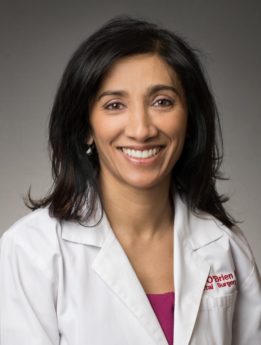 Lina O’Brien
Lina O’Brien
Mid-America Surgery Institute/HCA Midwest Health
In the study of logic, they call it Occam’s Razor—separating the clutter around a given mystery to identify the most likely causes of unknown phenomena. In medical school, you might call it Occam’s Scalpel: The tool that separates surgeons from other health-care providers. It showed up the first time Lina O’Brien sat in on an operating room surgery with a med-school classmate. “I came out of there and said, ‘I love this! I want to be in the operating room!” Her friend’s reaction? “I had it! I’m never doing this again!” So he went on to radiology, O’Brien says, “and I went into surgery. I love it when you’re looking at a very concrete problem, fixing something.” Exposure to the concepts of medicine and engineering during her youth may have had something to do with it, but with her parents from India steering her toward health care, surgery became a conflation of the two disciplines. The family immigrated to Canada when O’Brien was a child, and after 13 years, moved to Philadelphia, where she attended high school. After Penn State, she earned her medical degree at Jefferson College. The physicians’ group she works for is part of HCA Midwest Health, and there, she specializes in colorectal surgery. Many of those are cancer cases, but she does quite a bit of work with different diseases, she says. She’s also a specialist in robotic surgery, and the advances there have largely tracked with her own career. “It’s been an exciting time to practice,” O’Brien says. “When I finished my training, it was all big-incision surgery. Then when I first started, we were just starting with minimally invasive procedures.” That evolved into hand-assisted devices requiring smaller incisions, laparoscopy, and the ability to do more intricate procedures. “When robotics came about, it was even more exciting to see the improvements and see how patients benefited from it,” O’Brien says. “They don’t feel so much pain, and they bounce back better.” Modern tools are even more miniaturized, with smaller incisions and devices that rely on tactile senses rather than sweeping hand movements. “It’s fun to be in that, always learning, always developing new things,” O’Brien says. Not every procedure she performs is purely elective, so she retained a semblance of normalcy when the pandemic began closing down many operating room procedures in 2020. “I feel like we’re getting back to things being more normal now,” she says, and in her space, that’s a good thing. Other medical disciplines have benefitted from telehealth advances in the past two years, “but surgery is a thing you can’t really do with telehealth,” she says. As a whole, the population isn’t doing a good job with its collective health; increasing cases of obesity and diabetes concern her. “I don’t know how to fix that, but better access to health care is something that would benefit society as a whole,” she says.
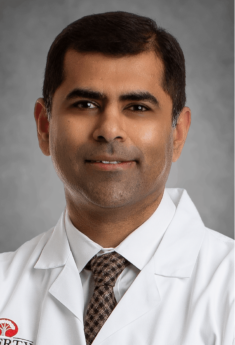 Dwarak Soundarraj
Dwarak Soundarraj
Liberty Hospital
The medical influences in Dwarak Soundarraj’s life came early, while he was growing up in southern India. Two of his uncles were doctors; one a general practitioner, one a pediatrician. “After high school, when I had to decide between engineering and medicine as career choices—the top two choices of most Indian kids of my era—I had suddenly realized that there was no choice to make,” Soundarraj says. “I wanted to be just like them, taking care of people and making a difference, one patient at a time.” Cardiology came to him like a revelation after reading a paper on electrocardiography by a South African physician. “Working in a public hospital with very limited resources and no access to echocardiography or any imaging other than X-ray, I was amazed by how much I can tell about someone’s heart with my stethoscope and an EKG,” Soundarraj says. “There was no dearth of clinical material ranging from rheumatic heart disease to complex congenital conditions at our hospital. An unsuccessful CPR attempt on another uncle who collapsed in our house and a few successful resuscitations in the cardiac care unit solidified my desire to be a cardiologist.” After medical school, he came to Michigan for residency and Chicago for his fellowship. That’s where the Midwestern appeal set in. “Kansas City is truly a hidden gem, not on most people’s radars when they are looking for a job,” he says, and for the past 10 years, he’s cast his lot with Liberty Hospital. “The strengths of the American health-care system in certain areas are undeniable,” Soundarraj says. “Excellent facilities, talented workforce, cutting-edge research, and better outcomes for certain conditions. However, we cannot improve the overall health of our population and stem the fall in life expectancy through the work of doctors in clinics and hospitals alone.” Free primary care and preventive care for all will be a start, he says, as will investments in nutrition and social services. Better care will also come from the removal of unnecessary regulations, improved price transparency for consumers and a more market-oriented approach to promote competition and reduce prices, he believes. Coming out of a global pandemic, Soundarraj says that COVID “made me realize that medicine will always remain an art, albeit an art that is deeply rooted in science. The more technologically advanced medicine becomes, the more imperative the need for empathic physicians to make thoughtful decisions for each patient’s unique circumstances. And it again reminded us that health care is teamwork and caring for each other in the team is important to be able to care for our patients.”
 Steven Starr
Steven Starr
North Kansas City Hospital/Meritas Health
A thriving burg of 2,800 souls, Girard, Kan., is nonetheless not exactly a hotbed of health-care delivery. But it was active enough to give Steven Starr an idea of what a medical career could entail. “My mother worked for one of the local physicians,” he recalls. “At an early age, I was exposed to general medicine. I saw how the community was dependent on the two physicians in town. They lived to serve their community, and I was impressed by their commitment.” A few years of working in the hay fields around Crawford County further cemented that impression, and he was off to the University of Kansas for the full slate of medical education—his M.D., residency, and fellowship—and there he made the call that cardiology would be the way forward. “It was a field that my brain understood,” Starr says. “If not for the cardiology rotation, my plan was to become a family practitioner in a small town.” Well, some small town’s loss was Kansas City’s gain—and vice versa for Starr. “Kansas City is an ideal city for me. It is close to my roots but also allows me to enjoy the amenities of a larger city,” he says. “A lot of my patients are from rural areas, which makes it easy for me to relate. I have been fortunate to practice with the same group of cardiologists since leaving my fellowship. North Kansas City Hospital is a top-quality hospital, and the leadership is supportive. I can’t imagine working anywhere else.” Nearly 30 years have passed since he completed his residency, but in the past two or so, his view of health-care delivery has changed a bit. “There is no doubt the pandemic has been a worldwide scourge,” Starr says. “I sympathize with all those who have lost someone due to COVID-19. The pandemic humbled me. I realized there is so much more we need to learn in treating diseases. There will always be a new disease to research and study. It also reaffirmed why I became a physician and reminded me of the oath I took to put my own health at risk to help others.” One other way to help patients, he suggests, would be to make medication more affordable. “I struggle on a daily basis to optimally treat patients who may not be able to afford top-tier medication but would benefit greatly from it,” he says. But many days also offer a brighter experience that validates his career choice. “There is nothing more rewarding than seeing patients who have had a heart attack walk out of the hospital days later,” Starr says. “In years past, many of these people would have died, but now we have the ability to save so many lives.”
 George Wright
George Wright
Stormont Vail Health
Working on the grunt side of health care—an orderly in a sizeable medical center—did not dissuade George Wright from the potential of a career in medicine. Just the opposite. “I volunteered as an orderly at St. Margaret’s hospital, and this led to my first job,” he recalls. “I was able to see what medical care was like, and while working with and learning from nurses, I was able to appreciate the care they provided and how hard they worked.” A native of Kansas City, Kan., who also learned about hard work and commitment on his way to earning his Eagle Scout rank, Wright also showed early promise when he earned a slot in a summer scholarship program in a virology lab at Children’s Mercy Hospital in Kansas City. The lab was run by Herbert Wenner, who had participated in the polio research that led to the vaccine in the 1950s. From there, Wright landed a research assistant job, then moved on to medical school and various rotations before deciding on family medicine and serving in the military. Following that service, he found his new home at the Cotton-O’Neil Clinic and Stormont Vail Hospital in Topeka. His career took an unexpected turn over the past two years with the unprecedented challenge of COVID-19. “That challenge has confronted me as a primary-care provider and leader,” he says, but “it has served as a catalyst. Early in the pandemic, I took the step from being the Medical Director of Family Medicine to Vice President of Primary Care Services. I was able to work with my outstanding multispecialty and multidisciplinary colleagues at our facility to develop our Enhanced Primary Care program. This program enabled us to expand our care through telemedicine and education of providers.” As a physician leader, he says, “the best thing I can do is to empower my colleagues, not just primary care providers, but specialists, nursing, really all of our team to provide the best care to all. I look forward to a time when we are able to reach those we don’t currently, including those who are uncomfortable entering our facilities, who can’t afford medical care, and those who are out of our reach.” His career, he says, has been marked by “incredible opportunities.” “While I can’t single out a single defining moment or patient that crystallized my purpose in medicine, I’ve been honored that my patients have trusted me to provide their health care,” Wright says. “I’ve cared for multiple generations of families and delivered babies of those I delivered. I’ve shared patients’ highs and lows, private worries and special joys, early mornings and late nights, first breaths, and the last ones. I’ve watched my patients play sports, enjoyed their activities, and been hugged at the grocery store. I’ve been honored and humbled that my patients have trusted me to provide their health care and considered me a friend and part of their family.”